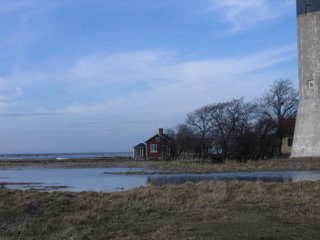Saturday, April 1: Let the twitching begin
We arrived at the chosen spot at about 7am, and there were already a couple of other birders with their telescopes set up on tripods. I spent most of the next hour and a half looking in this direction:

Hmmm, that horizon's not looking too straight: those binoculars must have been messing with my eyes. The darker strip on the horizon is mainland Sweden. This picture hints at the sheer drop to the water, probably about two floors in height. In the time we were there, I think about 3000 eiders passed. I liked watching fluid changes in the shape of the flocks. It seemed to be a special combination of individual and synchronised behaviour. Some mute swans swam below us and I found them more interesting than any of the other birders did.
Johan subscribes to an alerting service on his mobile phone, on which birders all over Sweden can text twitches of interest to all other subscribers. It beeped all weekend, sometimes with less than 10 minutes between alerts. But there were no alerts for king eiders on this morning. Gradually the birders got chatting, in Swedish of course. Johanna told me later that when things get quiet, birders typically exchange stories of memorable past twitches. At one point I think I caught a brief reference to my name alongside the words älg (moose) and matematik (it sticks out in polite conversation in any language, I think). They must have been wondering why the mute girl at the end was here fiddling uncertainly with a telescope. Particularly since Johanna and Astrid (the dog) were the only other females anyone had encountered that morning.
Here's a photo facing north-ish:

Unfortunately these pictures look a bit more drab than I remember it being: there should be a cute red cottage on that shoreline somewhere.
On the drive to the next birding spot, Johan pointed out a surfboard that had been set up as a sign at a crossroad. "Surfers' Paradise," he translated with a laugh. Apparently it's a popular location for windsurfers in the summer. I looked at the brown grass, the dirty patches of snow and the cold flat grey water. I reflected that it probably wasn't any less appealing to me than the skyscrapers, chunky gold jewellery and leathery skin of Queensland's namesake.
Our new location proved to be rather muddy, and there must have been a few dozen people out with their binoculars. (From now on, the hip term is 'bins'.) Females, even! I spotted a few middle-aged ladies wearing tweed and gumboots. If watching the eiders was like standing by a thoroughfare, this was more like sitting in the corner of a nightclub and observing the surrounding social rituals. A variety of ducks, geese and swans were hanging out, trying to impress each other. Here's a view, looking north, from the wooden platform we were on, about 4 floors high:

Next up was våfflor (waffles) for lunch! Apparently the previous Saturday (when I was listening to owls) was a special Swedish occasion necessitating the eating of waffles. There was some disagreement about the apppropriate translation of the name of the day, but it seemed to be about celebrating the arrival of spring. I was just watching my plate being heaped with fried batter, cloudberry jam and whipped cream, so I didn't quibble over the details.
The next item on the schedule, a nap, was postponed because the sun was still out. Johan, Johanna and I headed south to visit Långe Jan (Tall John), a lighthouse on the south coast. Johan described the area surrounding the lighthouse as the favourite birding spot of most Swedish enthusiasts. It was probably my favourite spot of the day, although the birds weren't the highlight for me (sorry, Johan). I twitched my first fallow deer, seeing four of them grazing in a field. Their antlers were amazing and, looking through the telescope, I felt as if I could reach out and stroke their velvety fur. Then, out to sea, were a few harbour seals playing in the water. Apparently there are a lot of adders around Långe Jan, but I was content not to add them to my twitch list.



0 Comments:
Post a Comment
<< Home